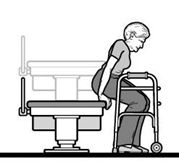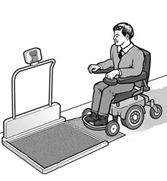(Printer-friendly PDF version | 443 KB)
(Large Print PDF version | 452 KB)
(Versión en español)
Introduction
The Americans with Disabilities Act (ADA) and Section 504 of the Rehabilitation Act require that health care providers provide individuals with disabilities full and equal access to their health care services and facilities. Title II of the ADA applies to public hospitals, clinics and health care services operated by state and local governments and Title III of the ADA applies to privately-owned and operated hospitals, clinics and health care providers. Section 504 of the Rehabilitation Act applies to recipients of federal financial assistance such as Medicaid and federally conducted programs.
Who Is Affected by Inaccessible Medical Facilities and Services?
Number of people in U.S. reporting a:
|
Mobility Disability = 19,937,600 |
Hearing Disability = 10,556,600 |
|
Vision Disability = 6,636,900 |
Cognitive Disability = 14,144,300 |
Source: U.S. Census Bureau - American Community Survey 2011
Is Your Facility Accessible for All Patients?
Make sure your facility has the following accessibility features:
|
|
|
|
|
|
|
|
Are your Examination Rooms and Medical Equipment accessible to patients who use mobility aids?
|
|
Provide a minimum clear floor space of 30 by 48 inches next to exam tables so that persons using a wheelchair or other mobility aid can transfer onto the tables. |
|
People using mobility aids must be able to transfer safely and easily to and from your exam tables and chairs. |
|
|
|
Your mammography equipment must be accessible for patients who use wheelchairs. |
|
Provide patient scales that are capable of weighing a person using a mobility aid like a wheelchair. |
|
|
|
Make sure your examination rooms provide clear floor space for a person to turn in a wheelchair or scooter. |
Are You Able to Effectively Communicate with Your Patients
Who Have Hearing, Vision, Speech or Cognitive Disabilities?
|
Type of Disability |
Some Suggestions for Accommodations |
|
Hearing |
|
|
Vision |
|
|
Speech |
|
|
Cognitive |
|
References
Access to Medical Care for Individuals with Mobility Disabilities. U.S. Department of Justice.
Effective Communication. U.S. Department of Justice.
Equal Rights Center. (2011). Ill-Prepared Health Care’s Barriers for People with Disabilities.
Lagu, T.,Hannon, N. S., Rothberg, M. B., & Wells, A. S., (2013). Access to Subspecialty Care for Patients with Mobility Impairment: A Survey. Ann Intern Med. 2013;158(6):441-446.
|
Content was developed by the Northwest ADA Center and is based on professional consensus of ADA experts and the ADA National Network. |
|
|
|
The contents of this factsheet were developed under grants from the National Institute on Disability, Independent Living, and Rehabilitation Research (NIDILRR grant numbers 90DP0095 and 90DP0086). NIDILRR is a Center within the Administration for Community Living (ACL), Department of Health and Human Services (HHS). The contents of this factsheet do not necessarily represent the policy of NIDILRR, ACL, HHS, and you should not assume endorsement by the Federal Government. |
|
© Copyright 2018 ADA National Network. All Rights Reserved. |
|

.png)










